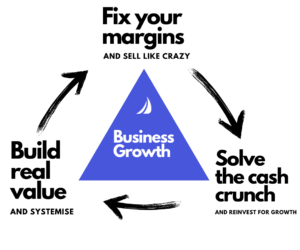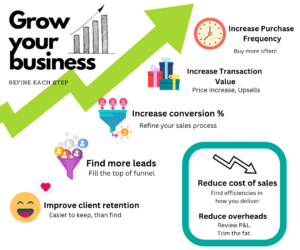Now – I get the resistance to this. I started my career at Ernst & Young where we tracked in 15-minute increments and HATED IT.
Culturally in a team – this is a very sensitive topic. Nobody wants to be a number – or have big brother watching over them.
If you are a service-based business.
The hard fact is that You make money through selling units of your team’s time.
Some call it your ‘human capital’
We only have a set number of hours available to use in a day/week/year.
Don’t you want to make sure that this finite resource is spent well?
More efficient = more productive = more money for less time.
Time off: Ever considered moving to a 4-day working week? Being efficient is critical.
How do you know if your team is efficient? You need to track your time
Problem-solving: For when things start to go off track and help you figure out why.
It also helps you plan your future resourcing more effectively.
Profitability: This is about working out which clients we are undercharging, or overservicing.
Demanding clients could be costing you thousands of dollars, but it’s all hidden on your Wage Expense line item.
KEY BENEFITS OF IMPLEMENTING TIME TRACKING
> You can run a more profitable business and pay your staff better
> You can stop working overtime on out-of-scope tasks
> Helps you avoid time-wasting meetings (both internal and external)
> You can see where your staffs time is being invested – The team is not overworking on the wrong clients or project
> You can take more time off knowing you have done enough
> You can move to a 4-day work week with confidence
Main Issues with Time Tracking
The main issues that staff might have when you first ask them to start tracking their time – and how to address them.
These really impact team culture if not handled properly.
| The issue with time tracking | Response |
| People feel they are being micromanaged by ‘big brother’ and not trusted to do their job | The focus is on CLIENT profitability, not individual employees. Make this clear. Show them how the data is being used, and how they are contributing to the overall success of the business that is paying their wage. |
| Creates more workload actually tracking time | It will take some time to become a habit amongst the team, but it does not take long to actually record. We only track KEY categories that are necessary to start, make it easy. |
| Amplifies productivity cost of task switching, people lose focus | Keep time-tracking BIG PICTURE to start, don’t need to have the clock on every minute. Staff can do a rough summary of where the time went so you stay in the flow. |
| Short tasks take more time to track than to perform | Simplify the buckets you are putting your time into. We still need to track non-billable time in some key categories but keep it simple |
| Time tracking encourages dishonesty | We are mainly focused on BROAD PICTURE trends, and where certain clients or departments are CONSISTENTLY trending the wrong way. Honesty in your team will happen over time as people get used to it, and see that it is not used against them. |
| It’s unnecessary | Yes – perhaps for some firms who already have a good feel for the right balance of tasks in their company. Hats off to them! This is for the rest of the agencies that are wondering why they are not as profitable as they think they should be. |
| We don’t charge by the hour so why do we need to track by the hour? | Your wage is the single largest cost of the business and regardless of how you price – you need to see where your time investment is being spent and if it can be better spent elsewhere. We want the best bang for our buck. |
How to get staff to track their time
- Take them on the journey: Be open about WHY this is important and how it helps the business.
- Make data visible and how it gives you better data over each client’s profitability
- Make it easy: DON’T OVERCOMPLICATE IT use the software you already have. e.g within Clickup, or Harvest
- Don’t use this in staff performance reviews – it will then encourage people to make things up
- Have champions in each department to follow up on any missed timesheets – team-based accountability is much more effective.
How Team Productivity Drives your revenue
- Outline the basics of team productivity and how it connects to your overall revenue
- How to compare expectations to reality to improve business performance
- How you can see this at the Client or department level
First start with your expectation: You need to first have a quote or an expectation of where you need to be, and why.
Examine the true goal for tracking this time to ensure all decisions are serving this purpose.
This comes from your pricing and quoting system – and how you are coming up with the price for your services.
We then compare this expectation VS reality.
| Quote (expectation) | Time Tracking (reality) |
| Project | SEO Retainer |
| Task 1 | Digital Strategy |
| Task 2 | Design |
| Task 3 | Development |
| Task 4 | Client Meetings |
- HOURS BUDGETED VS SPEND (BY CLIENT)
Hours per client.
The two key data points we are tracking are:
Hours budgeted per client
and Hours spent each month on this client
What is the difference between these two, and why?
- HOURS BUDGETED VS SPENT (BY CLIENT & TASK)
By Client and by Task
See below an example of potential tasks to track:
| SEO | Hours Budgeted |
| Digital Strategy | 2 |
| SEO | 4 |
| Outreach | 4 |
| Content Strategy | 5 |
| Design | 2 |
| Development | 1 |
| Client Strategy | 2 |
| Internal Meetings | 6 |
| Client Meetings | 4 |
- HOURS BUDGETED VS SPENT (BY DEPARTMENT, CLIENT, TASK)
By Department, by Client, and by Task.
This gives you the most amount of data when investigating where your jobs are going wrong, as you can see which role is doing what. It’s also the most complex and time-consuming to track.
It’s crucially important to map the key categories time is entered into by your team to the categories in your job estimates. .
This could just be a key category of an employee based on their pay and experience such as Junior, Mid, Senior
It could also be broken down into specific roles for each client.
For this more nuanced version, the data will then be broken up based on who is viewing it:
CEO/All hands meetings: Summary view per client
Account Managers: Summary view of their department & relevant clients
Employees: Summary of their specific clients
Metrics to track your efficiency
- ONE KEY Metric you can track from your profit and loss to help with team productivity
- How to compare Revenue Potential VS Reality to improve your performance
- How to compare expectations to reality to improve business performance
- How you can see this at Client or department level
Below is a metric you can run to give you a high-level idea of your efficiency overall.
Use Revenue per FTE
Annualised Rev per FTE = Total Annual Revenue / Full-time Equivalent employees
E.g $3mil in Revenue / 15 full-time employees = $200k revenue per employee.
I also do this for my clients on a monthly level, by just taking Revenue and X12
Monthly Rev per FTE = (Monthly Revenue x 12) / Full-time Equivalent employees
Rev
Using this you can still analyse how efficient your firm is at earning money, through a simple calculation that is based on your headcount – not your actual time spent.
Your firm should ideally be making at least $200,000 per employee as a benchmark.
NB: This is a very broad metric, and will not give you any detail about which clients or service lines are the best or worst.
It will help you work out how efficient your firm is at earning revenue compared to how many staff you have.
Those firms with better processes, more automated technology, and higher prices will naturally score well on this metric.
If you are not scoring well then ask yourself questions like:
> Do my staff have enough paying clients to work on?
>Am I overstaffed? Perhaps due to a lack of productivity from some
>If everyone is BUSY, and you are needing to hire but not profitable then you are either:
- Under-pricing
- Over-servicing
So find better clients and swap them out for the underperforming ones.



